 Steelers defensive Legend Jack Butler speaks as offensive Legend Dick Hoak looks on during a press conference introducing the team, Sept. 11, 2007 on the South Side.
Steelers defensive Legend Jack Butler speaks as offensive Legend Dick Hoak looks on during a press conference introducing the team, Sept. 11, 2007 on the South Side.By Scott Brown
PITTSBURGH TRIBUNE-REVIEW
Wednesday, September 12, 2007
The John "Blood" McNally coaching era may not have produced many wins, but it did beget its share of stories, such as the one Steelers chairman Dan Rooney told Tuesday.
McNally, who coached the team from 1937-39, only missed one game, Rooney said, and that was when he mistakenly thought the Pirates (that was the team's nickname before it became the Steelers) had a bye week. He went to watch the Chicago Bears play the Green Bay Packers, and a couple of reporters asked him in the press box why he wasn't at the Steelers' game. McNally told them that the Pirates were off that week.
"They said, 'Well, your team just scored seven points,' " Rooney said as the media room at the Steelers' South Side facility broke up in laughter.
The Steelers unveiled their "Legends Team" and added flavor to the players and times that preceded the 1970s with various anecdotes.
The team, which includes quarterback Bobby Layne, running back Dick Hoak and defensive back Jack Butler, is part of the Steelers' celebration of their 75th season.
It is different from the Steelers' all-time team, which will be voted on by fans, and the organization decided to have separate squads for a simple reason: a lot of what happened before the Steelers won four Super Bowls is obscured by the success the team has enjoyed since the 1970s.
"A lot of people in this town didn't know football existed before 1970 and they got a little bit spoiled," said Hoak, a running back for the Steelers from 1961-70.
Thirteen of the 24 members of the team, which includes four Pro Football Hall of Famers, are expected to be at Heinz Field on Sunday, and they will be honored at halftime of the game against the Buffalo Bills.
The Steelers will wear throwback uniforms for their 1 p.m. home opener.
"There were really so many good players, contrary to what many think going back to 1933," Rooney said, "and it was difficult to decide who should be on this team."
A panel that included Rooney, Hoak ("Dick didn't vote for himself," Steelers president Art Rooney II said with a laugh) and former Steelers broadcaster Myron Cope put together the team.
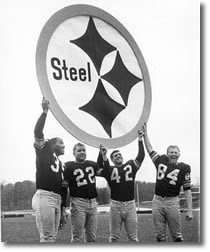 1962 Pittsburgh Steelers John Henry Johnson (#35), Bobby Layne (#22), Dick Hoak (#42), and Buddy Dial (#84) enjoy a light moment while holding high the original Steelmark, adopted that year on the team's helmet.
1962 Pittsburgh Steelers John Henry Johnson (#35), Bobby Layne (#22), Dick Hoak (#42), and Buddy Dial (#84) enjoy a light moment while holding high the original Steelmark, adopted that year on the team's helmet.Hoak, a Jeannette native, and Butler, who was born and raised in Pittsburgh, represented the team Tuesday. The simpler times in which they played became apparent when they were asked about the injury suffered by Bills tight end Kevin Everett last Sunday.
Everett sustained a serious cervical spine injury while making a tackle on special teams and may not walk again.
Hoak and Butler said such an injury never would have occurred when they played simply because the collisions weren't as violent, and people rarely lowered their head when they tackled since the helmets weren't very sophisticated.
Play-calling during those days also wasn't nearly as advanced as it is now, Hoak recalled.
Layne, a Hall of Famer, was a master at running the two-minute offense, said Hoak, and he took advantage of the baseball fields that most teams played on during that time.
"He would get down in the dirt and draw Xs and Os and tell us to go here and go there," Hoak said. "All of these plays, we made up in the huddle."
Following are brief bios on the members of the Steelers Legends Team.
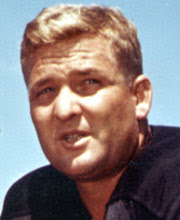 Bobby Layne
Bobby LayneQuarterback (1958-62)
One of the most colorful characters in the history of professional football, Bobby Layne gave the Steelers the kind of leadership they had never had before from a quarterback. Layne had the kind of personality that commanded respect, and then he solidified his status among his teammates with his performances on the field. He passed for 66 touchdowns and ran for eight more in 55 games for the Steelers. During Layne’s five seasons, the Steelers were 33-28-3, arguably the most successful such span to that point in franchise history. Layne was inducted into the Pro Football Hall of Fame in 1967.
 Dick Hoak
Dick HoakRunning Back (1961-70)
Known primarily by younger Steelers fans as an assistant coach who owned five Super Bowl rings, Dick Hoak is remembered by those who saw him play as a tough, productive halfback. An All-American at Penn State, Hoak was drafted by Pittsburgh in the seventh round of the 1961 NFL Draft. For his career, he rushed for 3,965 yards, caught 146 passes for 1,452 yards and scored 33 touchdowns. Hoak led the team in rushing in 1965, 1968 and 1969 and was named to the 1969 Pro Bowl. Upon his retirement following the 1970 season, he was the team’s No. 2 all-time leading rusher and is currently fifth on that list. Hoak went on to become the longest-tenured coach in team history, with 35 years as the running backs coach.
 John Henry Johnson
John Henry JohnsonRunning Back (1960-65)
It was 1964, and the 2-2 Steelers were going to Cleveland for a game against the Browns in which they supposedly had no chance. For sure, they had no linebackers, because of all the injuries at the position, but thanks to 200 yards rushing from John Henry Johnson, the Steelers pulled off a huge upset, 23-7. Originally drafted in the second round by the Steelers in 1953, Johnson played in Canada for one season, before spending three seasons each with the 49ers and Lions. However, Johnson enjoyed his finest seasons with the Steelers. He was the first player in team history to record a 1,000-yard rushing season, and he did it in both 1962 and 1964. When he retired in 1966 from the Houston Oilers, Johnson’s 6,803 career rushing yards were fourth all-time behind Jim Brown, Jim Taylor and Joe Perry. Johnson was inducted into the Pro Football Hall of Fame in 1987.
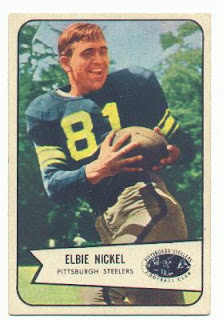 Elbie Nickel
Elbie NickelTight End (1947-57)
It wasn’t called tight end when he played it, but Elbie Nickel still played the position – known as “end” at the time – better than anybody in Steelers’ history. Nickel, drafted in the 15th round in 1947, finished his career with 329 receptions for 5,133 yards, both of which are fourth on the team’s all-time lists. He also hauled in 37 career touchdowns, which is the fifth-highest total in team history. Nickel led the NFL in yards per catch with a 24.3 average in 1949, but his best season was in 1952 when he posted 55 receptions for 884 yards and nine touchdowns, all of which were Steelers’ records at the time.
 Roy Jefferson
Roy JeffersonWide Receiver (1965-69)
Roy Jefferson was the team’s best offensive player when Chuck Noll was hired in 1969, but his decision to test the new head coach resulted in him being traded before the start of the 1970 season. Jefferson made two Pro Bowls in his five seasons with the Steelers after being selected in the second round of the 1965 NFL Draft. He became the first Steelers receiver to record back-to-back 1,000-yard seasons when he posted 1,074 in 1968 and followed up with 1,079 in 1969. In that two-year span, Jefferson also caught 20 touchdown passes.
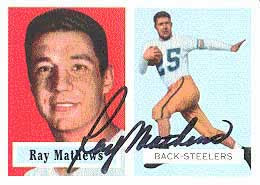 Ray Mathews
Ray MathewsWide Receiver (1951-59)
The Cleveland Browns dominated the All-American Football Conference and did the same to the Steelers by winning the first eight games of the home-and-home series. In 1955, the Steelers would beat them for the first time, and Mathews was a big reason why. In Pittsburgh’s 55-27 win, Mathews scored four touchdowns, including three on passes. Mathews led the team in receiving for three straight seasons from 1954-56, and he finished with 230 catches for 3,919 yards.
 Chuck Cherundolo
Chuck CherundoloCenter (1941-42, 1945-48)
As a player, he was the first of the distinguished group of centers employed by the Pittsburgh Steelers, and then when this part of his career ended, Chuck Cherundolo helped see to it that the legacy continued. The Steelers have had few centers during their 75-year history, and that’s a testimony to the quality of the players they’ve had there. Cherundolo was the first of the great ones. He entered the league in 1937 with the Cleveland Rams, played with the Philadelphia Eagles in 1940 and then came to Pittsburgh in 1941. In his day, only Bears Hall of Famer Clyde “Bulldog” Turner was considered a better center. When his playing career ended, Cherundolo stayed with the team as an assistant coach and tutored his replacement, Bill Walsh, to two Pro Bowls.
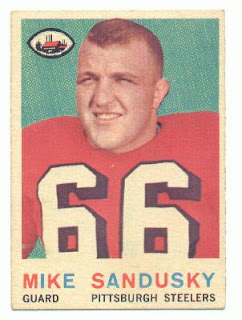 Mike Sandusky
Mike SanduskyOffensive Guard (1957-65)
Mike Sandusky played in 102 career games in his nine seasons with the Steelers and earned a Pro Bowl berth following the 1961 season. That year, the Steelers finished with a 6-8 record but sent a total of five players to the annual all-star game. Sandusky also helped protect quarterback Bobby Layne in 1958 as the team led the league in passing that year with 2,752, which was a team record at the time. He paved the way for John Henry Johnson to become the Steelers first 1,000-yard rusher in 1962 and guided the way again for Johnson in 1964 to eclipse the 1,000-yard barrier.
Bruce Van Dyke
Offensive Guard (1967-73)
It’s a story that has become part of the legend of the Pittsburgh Steelers. It was 1969, and the team was going through its first training camp under Chuck Noll while awaiting the arrival of the holdout No. 1 draft choice, Joe Greene. When Greene signed and reported for his first practice, Noll wanted to give the rookie a taste of the NFL. He chose Bruce Van Dyke to line up opposite Greene. Van Dyke entered the league as a 12th-round draft pick of the Philadelphia Eagles in 1966, and after joining the Steelers in 1967 he played 95 games for the team as a guard whose primary asset was his toughness. Van Dyke was traded to Green Bay in 1974.
Charley Bradshaw
Offensive Tackle (1961-66)
Coaches have been preaching this to players as long as the sport has been played: linemen who always are on the ground can’t make plays. During his six-year career with the Steelers, Charley Bradshaw’s clean uniform always had a way of standing out. An eighth-round pick by the Los Angeles Rams in 1958, Bradshaw came to the Steelers in 1961 and started every game at tackle (82 straight) for the team through the 1966 season. John Henry Johnson posted the first two 1,000-yard seasons in franchise history, and he did it behind offensive lines that had Charley Bradshaw at tackle.
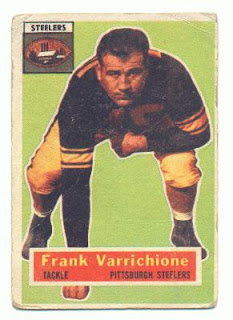 Frank Varrichione
Frank VarrichioneOffensive Tackle (1955-60)
In 1957, the Steelers were going to Baltimore to play a Colts team that would win back-to-back championships in 1958-59, a team with a future Hall of Famer named Gino Marchetti at defensive end, one of the game’s all-time greats. Steelers coach Buddy Parker wasn’t real trusting of young players, and since Frank Varrichione was a third-year guy, Parker spent the week leading up to the Colts game trying other players at the position. Varrichione beat off the competition and stoned Marchetti in a game the Steelers won, 19-13. At the Pro Bowl following the season, Varrichione was told that Browns coach Paul Brown used the film of him vs. Marchetti as a teaching tool for his own offensive linemen. In six seasons with the Steelers, Varrichione was voted to five Pro Bowls.
 Eugene “Big Daddy” Lipscomb
Eugene “Big Daddy” LipscombDefensive Line (1961-62)
“I just wrap my arms around the whole backfield and peel ‘em off one-by-one until I get to the ball carrier. Him I keep.” And so it was that Eugene “Big Daddy” Lipscomb described his playing style, which also was characterized this way by Steelers coach Buddy Parker: “He was the best man I ever saw at knocking people down.” At 6-foot-6, 300 pounds, Lipscomb was a force the likes of which the NFL never had seen. He is said to have invented “pursuit” when he became the first defensive lineman to chase the football all over the field. Discovered by the Los Angeles Rams in a Marine Corps camp, Lipscomb never went to college but played for the Rams, then was part of two NFL Championships in Baltimore before ending with the Steelers. He died prematurely in 1963 at the age of 31.
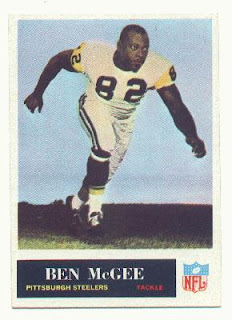 Ben McGee
Ben McGeeDefensive Line (1964-72)
Ben McGee was a fourth-round draft pick by the Steelers in 1964 out of Jackson State and went on to become one of the top defensive ends in his time. He twice went to the Pro Bowl following the 1966 and 1968 seasons. In his final season with the team, he helped the Steelers to an 11-3 record while winning the AFC Central title for the first time in team history. McGee and the Steelers advanced to the AFC Championship Game before falling to the Miami Dolphins. He played in 119 games for Pittsburgh and finished his career with seven fumble recoveries.
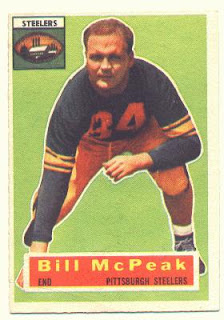 Bill McPeak
Bill McPeakDefensive Line (1949-57)
Versatility is one thing, but Bill McPeak took that to extremes during his career with the Steelers. McPeak was born and raised about 90 minutes northwest of Pittsburgh in New Castle, Pa. Originally drafted by Paul Brown, who called his decision to cut the rookie one of the blunders of his career, McPeak was a starter as soon as he joined the Steelers in 1949, and before he turned 30 he served the team as a player, assistant coach and scout. In 1956-57, McPeak was a player, coach and scout all at once, and he stayed on as a coach/scout for another year after he retired as a player. McPeak missed only three games in nine years and was voted to the Pro Bowl three times.
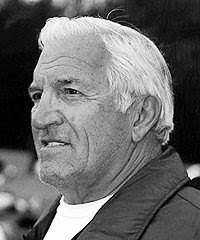 Ernie Stautner
Ernie StautnerDefensive Line (1950-63)
“That man ain't human. He's too strong to be human ... He's the toughest guy in the league to play against because he keeps coming head first. Swinging those forearms wears you down.” That’s the way Hall of Fame offensive lineman Jim Parker once described Ernie Stautner. A nine-time Pro Bowl selection, Stautner came to the Steelers as a second-round draft choice from Boston College who had been told by the New York Giants that he was too short to play professional football. But he anchored Pittsburgh’s defense for 14 seasons and was voted the NFL’s Best Lineman Award in 1957 because of his strength and toughness. “What made him was his strength,” said Dan Rooney. “This was a time when players didn’t lift weights. I remember we were playing the Giants at Forbes Field one time and it was a very close game, and they were moving the ball. He sacked the quarterback three times in a row.” The Steelers retired his No. 70 jersey in 1964 following his retirement, and he remains the only Steelers player to have received that honor. He was inducted into the Pro Football Hall of Fame in 1969.
 Dale Dodrill
Dale DodrillLinebacker (1951-59)
A very tough, physical and demanding player during his time, Dale Dodrill became one of the top linebackers in the league after being a sixth-round draft pick by the Steelers in 1951. He earned four trips to the Pro Bowl (1954, 1955, 1956 and 1958), becoming the second player in team history to do so at the time behind Ernie Stautner.
Myron Pottios
Linebacker (1961-65)
Myron Pottios was a good player for the Pittsburgh Steelers in his day, good enough to catch George Allen’s eye. The team’s first pick (second round) in the 1961 NFL Draft, Pottios played his first four seasons in the league with Pittsburgh. He played in 41 career games for the Steelers and finished with seven interceptions while earning two trips to the Pro Bowl. When Allen took over as the head coach of the Los Angeles Rams, he immediately made a deal for Pottios, and then Allen also took him to Washington, D.C., when he became head coach of the Redskins in 1971. The 1963 All-NFL team featured three linebackers from Western Pennsylvania – Pottios, from Charleroi, Joe Schmidt from Pittsburgh, and Bill George from Waynesburg.
Jerry Shipkey
Linebacker (1948-52)
Jerry Shipkey came into the league as an offensive threat, scoring eight touchdowns as a rookie, but turned into one of the top defensive players at his position by the time he was through. In just five seasons with the team, he posted 13 interceptions for 238 yards and earned Pro Bowl berths following the 1950, 1951 and 1952 seasons. A sixth-round draft choice in 1947, he joined fellow standouts in an outstanding rookie class that included Elbie Nickel and John Mastrangelo that were drafted by legendary coach Jock Sutherland.
Jack Butler
Defensive Back (1951-59)
It is said that defensive backs often choose between making a play on the football or making a play on the receiver. Jack Butler did both. Described by former Pittsburgh Press sports editor Pat Livingston as “having the face of a choirboy and the heart of an arsonist,” Butler played nine seasons with the Steelers and recorded 52 interceptions in 103 games, and the guy who once studied to become a priest accomplished that in a most uncharitable way. “The best pass defense is the respect of the receivers,” said Butler. “If they know they’re going to get hit as soon as they touch the ball, they’re not so relaxed catching it.” When Butler’s stellar career ended, only Hall of Famers Dick “Night Train” Lane and Emlen Tunnell had more interceptions than him. Butler never played high school football, and only tried out at St. Bonaventure College as a lark. Father Dan Rooney, a priest at St. Bonaventure, recommended Butler to his brother, who just happened to be Art Rooney Sr., the founder of the Pittsburgh Steelers. Butler finished his career with four consecutive trips to the Pro Bowl from 1956-1959.
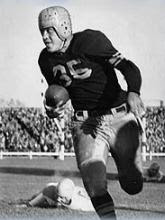 Bill Dudley
Bill DudleyDefensive Back/Running Back (1942, 1945-46)
Who is the last Steelers running back to lead the NFL in rushing? Here’s a hint: He also led the NFL in interceptions and punt returns that same season. “Bullet” Bill Dudley was a first-round pick of the Steelers in 1942 and finished as the NFL’s leading rusher twice in his three seasons with the team – 1942 and 1946. Dudley was in the military for the 1943 and 1944 seasons. He rushed for 696 yards in 1942, and then in 1946, Dudley led the league in three distinctly different statistical categories: rushing (604 yards), punt returns (27 for 385 yards) and interceptions (10). That year he was named the NFL’s Most Valuable Player. Dudley was inducted into the Pro Football Hall of Fame in 1966.
Howard Hartley
Defensive Back (1949-52)
The Washington Redskins didn’t really know what they had when they signed an undrafted free agent from Duke named Howard Hartley in 1948, and they sure didn’t know what they would be losing when they decided to release him after that one season. The Steelers knew what they had in Hartley, even if they didn’t have him for very long. In a three-season span, 36 games, Howard Hartley intercepted 21 passes for the Steelers, including 10 in 1951. For his career, Hartley played in 45 games for the Steelers and recorded 25 interceptions.
Clendon Thomas
Defensive Back (1962-68)
On offense, he averaged 18.2 yards on 42 career catches for the Steelers and scored two touchdowns. On defense, he had 23 interceptions. He could punt, if necessary; he returned kicks when asked. Clendon Thomas was a football player. In college, Clendon Thomas played a key role on Oklahoma’s back-to-back national championship teams of 1955-56, and he would lead the Sooners in scoring in both 1956 and 1957. His combination of speed, strength and lateral movement made him not only a great halfback, but also an excellent defensive back. Against Notre Dame in 1956, Thomas intercepted a Paul Hornung pass and returned it for a touchdown. After four seasons with the Los Angeles Rams, Thomas joined the Steelers, where he played the final seven of his 11 NFL seasons. Having recently sold his chemical company, Thomas currently lives in Oklahoma City.
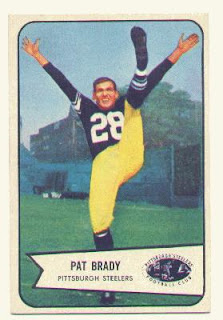 Pat Brady
Pat BradyPunter (1952-54)
If practice indeed makes perfect, Pat Brady was in a good spot to hone his punting skills. In three seasons for Steelers teams that finished a combined 16-20, Brady punted 223 times and averaged 44.5 yards on those kicks. In 1953, Brady led the NFL in punts (80), yards (3,752) and average (46.9). The following season, Brady again led the NFL with a 43.2-yard average. Brady’s 46.9-yards per punt average is still the second-highest single-season average in team history. Brady was also a member of the Steelers 50th Anniversary team.
Armand Niccolai
Kicker (1934-42)
Armand Niccolai played nine seasons for the Pittsburgh Pirates/Steelers after attending nearby Duquesne University. He led the team in scoring in four years, including posting a personal-best 28 points in both 1935 and 1936. He booted a Steelers’-best seven field goals in 1936, which that mark would not be broken for the next 14 years.
Scott Brown can be reached at sbrown@tribweb.com or 412-481-5432.


No comments:
Post a Comment